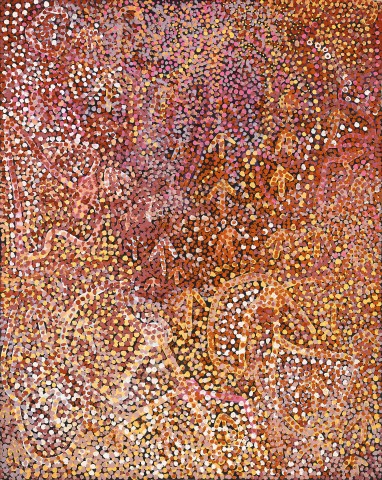UNTITLED (ALALGURA/EMU COUNTRY), 1989
EMILY KAME KNGWARREYE
synthetic polymer paint on canvas
150.0 x 120.5 cm
bears inscription verso: artist’s name and Delmore Gallery cat. E013
bears inscription on label verso: Kngwarreye, E / Alalgura – Emu Country / CS ‘98
Commissioned by Delmore Gallery, via Alice Springs in 1989
Coventry Gallery, Sydney
Private collection, Sydney
Hogarth Galleries, Sydney
The Laverty Collection, Sydney, acquired from the above in September 1995
Emily Kngwarreye, Coventry Gallery, Sydney, 8 May – 2 June 1990, cat. 7
Southern Reflections – Ten Contemporary Australian Artists, Art Gallery of New South Wales, Sydney, 1998; Kulturhuset (Cultural Centre) Stockholm, Sweden, 1998; Stenersen Museum, Oslo, Norway, 1999; Göteborgs Konsthall, Gothenburg, Sweden, 1999, cat. 7
Mapping Our Countries, Djamu Gallery, Australian Museum at Customs House, Sydney, 9 October 1999 – 27 February 2000
Cross, E., Southern Reflections – Ten Contemporary Australian Artists, Art Gallery of New South Wales, Sydney, 1998, cat. 7, p. 21 (illus.)
Beyond Sacred: Australian Aboriginal Art: The Collection of Colin and Elizabeth Laverty, Hardie Grant Books, Melbourne, 2008, pp. 90 (illus.), 339
Beyond Sacred: Australian Aboriginal Art: The Collection of Colin and Elizabeth Laverty, edition II, Kleimeyer Industries Pty Ltd, Melbourne, 2011, pp. 96 (illus.), 389
‘All the paintings of Emily Kngwarreye, so spectacular and diverse in style, express a central theme – that of her identification with the earth and land itself: Anmatyerre country, the country of the yam and the emu’.1
When describing the first paintings on canvas produced by Kngwarreye such as Untitled (Alalgura/Emu Country), 1989, Judith Ryan sees a connection to, as well as an evolution from her earlier batiks, noting that these canvases ‘retain the linear network as an underlayer or foundation, but the dots that were subsidiary in her batik come to the surface… lines and dots converge in a dense field of irregular textured marks which create a sense of depth.’2
Recorded as E013 in the Delmore Gallery index of works, Untitled (Alalgura/Emu Country) was the second of eight paintings by Emily Kngwarreye produced at Delmore Downs Station in December 1989. One month later, towards the end of January 1990, the painting was consigned for sale at Coventry Gallery in Sydney.3 A significant early work, Untitled (Alalgura/Emu Country), 1989, conveys the artist’s custodial responsibility for the Yam and the Emu, reflecting Kngwarreye’s connection to country and Women’s ceremonies through body painting and dance. Here the tracery of grey and milky white lines signifies the meandering roots of the yam below the earth with the tracks of the travelling emu above moving between nesting sites. The underlying linear pattern is submerged by in a profusion of overlapping dots painted in a limited palette of ochres (red, yellow and white), together with soft blues and pinks. Fundamentally, this work depicts the relationship between the emu and country. Beneath the soil the bush yam is ready for digging, while above, there is a flurry of movement as the male emu moves across the landscape feeding on various seeds, simultaneously shepherding his chicks into areas where the yam thrives.
From the very beginning ‘Emily Kngwarreye was noticeable for the dedication and passion which she applied herself… her work stood out for its spontaneity and verve’4,and her legacy in the history of twentieth century Australian art cannot be overstated. The body of work produced in the final stage of her life radically altered the way in which we view and appreciate modern Aboriginal art. Stemming from a lifetime of making art, where the visual and performative aspects are as important as language, her paintings reveal a deep affinity to country and a devotion to women’s ceremony in song, dance and the ceremonial painting of bodies. Celebrating the ever-changing seasonal variations in her homeland of Alhalker and the related spiritual and domestic obligations to country, Kngwarreye’s painting demonstrates the interconnectedness of life, landscape and culture.
1. Isaacs, J., ‘Anmatyerre Woman’ in Emily Kngwarreye Paintings, Craftsman House, Sydney, 1998, p. 12
2. Ryan, J., ‘Emily Kngwarreye in the National Gallery of Victoria’ in Emily Kngwarreye Paintings, ibid., p. 79
3. Information from the Delmore Gallery database, provided by Janet Holt, October 2022
4. Jenny Green cited in Hart, D., Emily Kame Kngwarreye, Paintings from 1989 – 1995, exhibition catalogue, Parliament House, Canberra, 1995, n.p.
CRISPIN GUTTERIDGE
